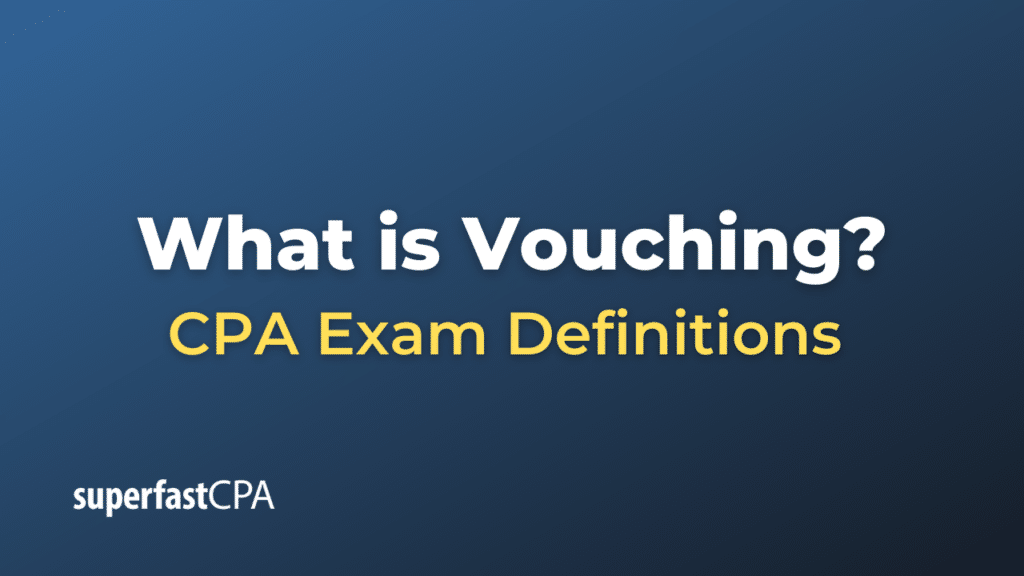Vouching
Vouching is an auditing process in which an auditor examines the documentary evidence supporting accounting transactions to confirm their validity, accuracy, and completeness. The primary purpose of vouching is to establish that the financial records presented are authentic, thus providing assurance that they are a reliable basis for the preparation of financial statements.
Vouching involves the verification of entries in the accounting books with the help of vouchers, invoices, receipts, and other documentary evidence. The auditor scrutinizes these documents to make sure they support the transactions recorded in the company’s accounting system. This helps to detect errors, omissions, or fraudulent activities that could distort the financial statements.
Steps Involved in Vouching:
- Documentary Evidence: Obtain all relevant documents like invoices, receipts, bank statements, and contracts that support the recorded transactions.
- Comparison: Compare the details of the documents to the corresponding entries in the accounting records. This could involve checking:
- Dates
- Amounts
- Authorization signatures
- Supporting calculations
- Verifying Authenticity: Ensure that the documents are legitimate, authorized, and have not been tampered with.
- Completeness: Check that all relevant transactions have been recorded and documented.
- Follow-Up: If discrepancies are found, they must be investigated to determine whether they are due to errors or intentional misrepresentations.
- Documentation: Keep a record of the vouching process, highlighting any issues discovered and the steps taken to resolve them.
Importance of Vouching:
- Integrity of Financial Statements: Ensures that the financial statements are based on authentic and accurate transactions.
- Detection of Fraud: Helps to detect irregularities, fraudulent activities, or errors that could otherwise go unnoticed.
- Compliance: Assures that the organization is complying with accounting standards and legal requirements.
- Internal Controls: Evaluates the effectiveness of the organization’s internal control systems.
- Investor and Stakeholder Confidence: Builds confidence in the financial information disclosed by the company, which can be crucial for investors, lenders, and other stakeholders.
In sum, vouching is a cornerstone activity in the auditing process, aimed at verifying the legitimacy and accuracy of accounting records. It provides a level of assurance that the financial statements can be relied upon.
Example of Vouching
Let’s look at a simplified example to understand the process of vouching in an audit scenario.
- Company Name: FreshFoods Grocery Store
- Industry: Retail
- Audit Period: January 2022
Transaction for Vouching:
FreshFoods has recorded a sales revenue of $20,000 for the month of January 2022.
Auditor’s Steps:
- Select Transaction to Vouch: The auditor randomly selects sales transactions from the month of January 2022 in FreshFoods’ accounting records for vouching.
- Documentary Evidence: The auditor requests sales invoices, receipt copies, and bank deposit slips for the selected transactions.
- Comparison: The auditor compares the following details:
- The date of the transaction recorded in the books with the date on the sales invoice and receipt.
- The amount recorded in the books ($20,000 in total for the selected transactions) against the amounts in the invoices, receipts, and bank deposit slips.
- Signatures and authorizations on the invoices and receipts to ensure they were approved by authorized personnel.
- Verifying Authenticity: The auditor confirms that the invoices and receipts are original documents, not duplicates or forgeries. This might include contacting customers to confirm the validity of the transactions or checking digital timestamps on electronic records.
- Completeness: The auditor examines whether all relevant sales transactions for January 2022 are recorded and supported by proper documentation. They also look for any omitted transactions.
- Follow-Up: No discrepancies are found in this example. If there had been, the auditor would investigate further to find the root cause—whether it was an error or intentional misrepresentation.
- Documentation: The auditor records the steps taken in the vouching process, noting that the transactions for January 2022 are accurate and complete. This becomes part of the audit working papers.
Outcome:
In this example, the vouching process verifies the accuracy and completeness of the recorded sales transactions for FreshFoods Grocery Store for the month of January 2022. This adds a level of assurance to the audit, confirming that the sales revenue for January 2022 is indeed $20,000 and is supported by appropriate documentation and authorizations.
By going through this vouching process, the auditor has gained more confidence in the reliability of FreshFoods’ financial statements for the audit period, specifically regarding sales revenue. This helps in forming an audit opinion and provides assurance to stakeholders like investors, regulators, and management.













